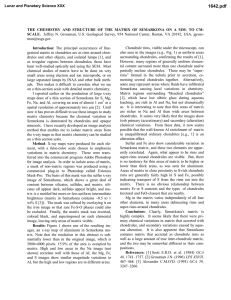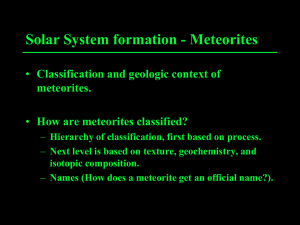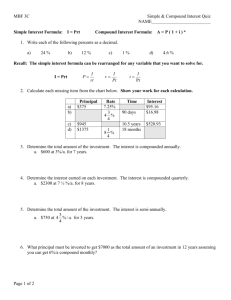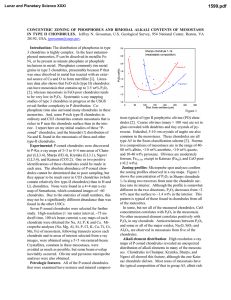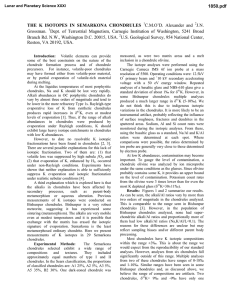Compound Chondrule Formation Via Instantaneous Crystallization
advertisement
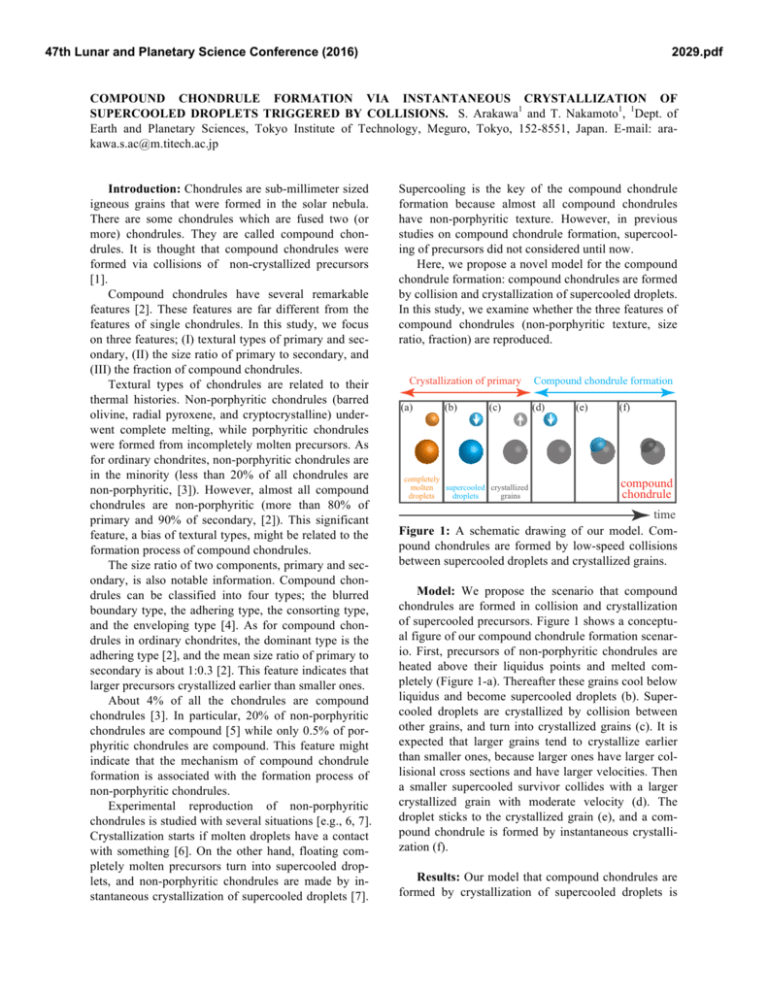
47th Lunar and Planetary Science Conference (2016) 2029.pdf COMPOUND CHONDRULE FORMATION VIA INSTANTANEOUS CRYSTALLIZATION OF SUPERCOOLED DROPLETS TRIGGERED BY COLLISIONS. S. Arakawa1 and T. Nakamoto1, 1Dept. of Earth and Planetary Sciences, Tokyo Institute of Technology, Meguro, Tokyo, 152-8551, Japan. E-mail: arakawa.s.ac@m.titech.ac.jp Introduction: Chondrules are sub-millimeter sized igneous grains that were formed in the solar nebula. There are some chondrules which are fused two (or more) chondrules. They are called compound chondrules. It is thought that compound chondrules were formed via collisions of non-crystallized precursors [1]. Compound chondrules have several remarkable features [2]. These features are far different from the features of single chondrules. In this study, we focus on three features; (I) textural types of primary and secondary, (II) the size ratio of primary to secondary, and (III) the fraction of compound chondrules. Textural types of chondrules are related to their thermal histories. Non-porphyritic chondrules (barred olivine, radial pyroxene, and cryptocrystalline) underwent complete melting, while porphyritic chondrules were formed from incompletely molten precursors. As for ordinary chondrites, non-porphyritic chondrules are in the minority (less than 20% of all chondrules are non-porphyritic, [3]). However, almost all compound chondrules are non-porphyritic (more than 80% of primary and 90% of secondary, [2]). This significant feature, a bias of textural types, might be related to the formation process of compound chondrules. The size ratio of two components, primary and secondary, is also notable information. Compound chondrules can be classified into four types; the blurred boundary type, the adhering type, the consorting type, and the enveloping type [4]. As for compound chondrules in ordinary chondrites, the dominant type is the adhering type [2], and the mean size ratio of primary to secondary is about 1:0.3 [2]. This feature indicates that larger precursors crystallized earlier than smaller ones. About 4% of all the chondrules are compound chondrules [3]. In particular, 20% of non-porphyritic chondrules are compound [5] while only 0.5% of porphyritic chondrules are compound. This feature might indicate that the mechanism of compound chondrule formation is associated with the formation process of non-porphyritic chondrules. Experimental reproduction of non-porphyritic chondrules is studied with several situations [e.g., 6, 7]. Crystallization starts if molten droplets have a contact with something [6]. On the other hand, floating completely molten precursors turn into supercooled droplets, and non-porphyritic chondrules are made by instantaneous crystallization of supercooled droplets [7]. Supercooling is the key of the compound chondrule formation because almost all compound chondrules have non-porphyritic texture. However, in previous studies on compound chondrule formation, supercooling of precursors did not considered until now. Here, we propose a novel model for the compound chondrule formation: compound chondrules are formed by collision and crystallization of supercooled droplets. In this study, we examine whether the three features of compound chondrules (non-porphyritic texture, size ratio, fraction) are reproduced. Crystallization of primary (a) (b) (c) completely molten supercooled crystallized grains droplets droplets Compound chondrule formation (d) (e) (f) compound chondrule time Figure 1: A schematic drawing of our model. Compound chondrules are formed by low-speed collisions between supercooled droplets and crystallized grains. Model: We propose the scenario that compound chondrules are formed in collision and crystallization of supercooled precursors. Figure 1 shows a conceptual figure of our compound chondrule formation scenario. First, precursors of non-porphyritic chondrules are heated above their liquidus points and melted completely (Figure 1-a). Thereafter these grains cool below liquidus and become supercooled droplets (b). Supercooled droplets are crystallized by collision between other grains, and turn into crystallized grains (c). It is expected that larger grains tend to crystallize earlier than smaller ones, because larger ones have larger collisional cross sections and have larger velocities. Then a smaller supercooled survivor collides with a larger crystallized grain with moderate velocity (d). The droplet sticks to the crystallized grain (e), and a compound chondrule is formed by instantaneous crystallization (f). Results: Our model that compound chondrules are formed by crystallization of supercooled droplets is 47th Lunar and Planetary Science Conference (2016) based on the textural feature that almost all components of compound chondrules have experienced complete melting and supercooling. Thus, this model naturally explains the feature (I). Also, this model can reproduce the size difference of primary to secondary (Feature II) by size dependence of collision frequency. In addition, this model might reproduce the abundance of compound chondrules (Feature III) due to a long duration of supercooling [8]. The fraction of compound chondrules fCC is estimated from the product of the number density of precursor particles n, the collisional cross section σ, the collisional velocity v, and the duration of compound chondrule formation t. The collisional cross section σ and the collisional velocity v are hardly dependent on the mechanisms of chondrule formation. The collisional cross section σ is given from the typical radius of chondrules. The observational study of chondrite thin sections reveals that the mean radius of primaries is about 0.4 mm and the mean radius of secondaries is about 0.1 mm [2]. Then we obtain the collisional cross section is σ = π (0.4 mm + 0.1 mm)2 = 0.8 mm2. The collisional velocity v is limited by the upper limit of the collisional velocity for sticking. The viscosity of supercooled droplets might be a moderate value, hence a supercooled droplets behaves not as a elastic body but as a fluid body when the droplet collides with other grains. The upper limit of collisional velocity is of the order of 10 m s-1, which is expected from experimental studies of droplet collisions [13, 14]. In this study, we assume that the collisional velocity is v = 3 m s-1. In contrast, the number density n and the duration of compound chondrule formation t are strongly dependent on mechanisms of chondrule formation, such as planetesimal bow shock [9, 10], impact jetting [11], lightning [12], and so forth. Then, we have n t = fCC/(σ v) = 8 × 10-2 cm-3 s, where the fraction of compound chondrules in non-porphyritc chondrules fCC = 20% is adopted. The supercooling phase can be sustained long time. According to laboratory experiments, it can be as long as 1000 sec or more [7]. This duration seems to be longer than the duration of compound chondrule formation time assumed in previous studies. This implies that the required number density of precursors could be lower than that expected in previous works. Discussions: If we assume that compound chondrules are formed in planetesimal bow shocks, the duration of compound chondrule formation can be of the order of 10 hours [10]. Then the number density of chondrules that is required from the fraction of compound chondrules is 2 × 10-6 cm-3. This value is 2029.pdf achieved if the dust-to-gas mass ratio is 1:1 in the midplane of the solar nebula [15], and this dust-rich environment is also required from the abundance of volatile elements in chondrules [16]. Conclusions: We showed that three features of compound chondrules can be reproduced if (1) nonporphyritic chondrules are formed from supercooled precursors, (2) compound chondrules are produced by instantaneous crystallization of supercooled droplets triggered by collisions, and (3) the product of the number density of chondrules and the duration of compound chondrule formation, i.e., the duration of supercooling is of the order of 10-1 cm-3 s. Thanks to the supercooling, the duration of compound chondrule formation t can be long, so the required number density n may be low. Acknowledgements: This work is supported by JSPS KAKENHI Grant Number 15K05266. References: [1] Ciesla F. J. (2006) Meteoritics & Planet. Sci. 41, 1347. [2] Wasson J. T. et al. (1995) GCA 59, 1847. [3] Gooding J. L. and Keil K. (1981) Meteoritics 16, 17. [4] Akaki T. and Nakamura T. (2005) GCA 69, 2907. [5] Ciesla F. J. et al. (2004) Meteoritics & Planet. Sci. 39, 531. [6] Tsuchiyama A. et al. (2004) GCA 68, 653. [7] Nagashima K. et al. (2006) J. of Crystal Growth 293, 193. [8] Tanaka K. K. et al. (2008) J. of Crystal Growth 310, 1281. [9] Iida A. et al. (2001) Icarus 153, 430. [10] Morris M. A. et al. (2012) ApJ 752, 27. [11] Johnson B. C. et al. (2015) Nature 517, 339. [12] Horanyi M. et al. (1995) Icarus 114, 174. [13] Ashgriz N. and Poo J. Y. (1990) J. of Fluid Mech. 221, 183. [14] Chen R. H. and Wang H. W. (2005) Experiments in Fluids 39, 754. [15] Hayashi C. (1981) Progress of Theoretical Physics Supplement 70, 35. [16] Alexander C. M. O. et al. (2008) Science 320, 1617.
